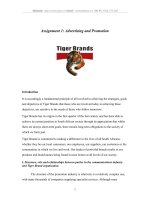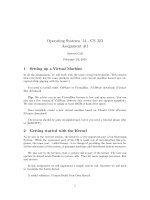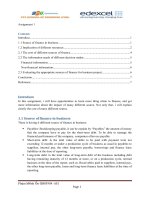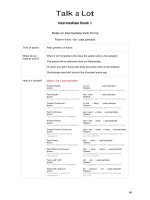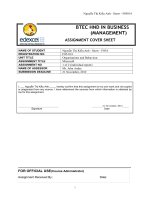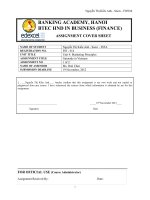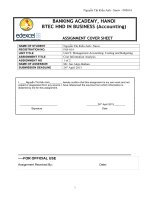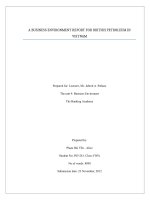1631 assignment 1 (pass)
Bạn đang xem bản rút gọn của tài liệu. Xem và tải ngay bản đầy đủ của tài liệu tại đây (1.28 MB, 34 trang )
Software Development Life Cycle - Assignment
1
ASSIGNMENT 01 FRONT SHEET
Qualification
BTEC Level 5 HND Diploma in Computing
Unit number and
title
Unit 09: Software Development Life Cycle
Submission date
Date Received 1st
submission
Re-submission
Date
Date Received 2nd
submission
Student Name
ĐÀO VĨNH KHANG
Student ID
GCS200222
Class
GCS0905B
Assessor name
VO THAO
Student declaration
I certify that the assignment submission is entirely my own work and I fully understand the
consequences of plagiarism. I understand that making a false declaration is a form of malpractice.
Student’s signature
KHANG
Grading grid
P1
P2
P3
P4
M1
M2
D1
D2
1
❒ Summative Feedback:
Grade:
Assessor Signature:
Internal Verifier’s Comments:
Signature & Date:
❒ Resubmission Feedback:
Date:
CONTENTS
CONTENTS .......................................................................................................................................................................... 1
I. SOFTWARE DEVELOPMENT LIFE CYCLES MODELS (P1) ..................................................................................................
3
1.
Iterative models
........................................................................................................................................................ 3 i. Spiral Model
............................................................................................................................................................... 3 ii. Agile Model
............................................................................................................................................................... 5 2. Sequential
models ..................................................................................................................................................... 7 i. Waterfall
Model ......................................................................................................................................................... 7
ii. Prototype model......................................................................................................................................................... 9
II. HOW RISK IS MANAGED IN THE SPIRAL LIFECYCLE MODEL (P2) ................................................................................. 12
1.
Why a life cycle model is chosen for a specific development environment .............. Error! Bookmark not
defined. 2. Changing in requirements .......................................................................................... Error! Bookmark not
defined.
3. For instance: TUNE SOURCE ........................................................................................ Error! Bookmark not defined.
i. Identification ................................................................................................................ Error! Bookmark not defined.
ii. Design .......................................................................................................................... Error! Bookmark not defined.
iii. Construct .................................................................................................................... Error! Bookmark not defined.
iv. Evaluation and Risk Analysis ...................................................................................... Error! Bookmark not defined.
IV. FEASIBILITY STUDY (P3) .............................................................................................................................................. 16
1. Feasibility study ....................................................................................................................................................... 16
2. Feasibility report ..................................................................................................................................................... 16
V. FEASIBILITY CITERIA (P3) ............................................................................................................................................. 19
1. Technical feasibility ................................................................................................................................................. 19
2. Schedule feasibility.................................................................................................................................................. 20
3. Legal issues (Wen, 2018) ......................................................................................................................................... 20
4. Social issues ............................................................................................................................................................. 21
5. Economic feasibility................................................................................................................................................. 21
VI. HOW TECHNICAL SOLUTIONS CAN BE COMPARED (P4) ............................................................................................ 24
4. Outcome ..................................................................................................................... Error! Bookmark not defined.
VIII. References ............................................................................................................................................................... 25
FIGURES AND TABLES
Figure 1: SPIRAL MODEL .................................................................................................................................... 3
Figure 2: AGILE MODEL ...................................................................................................................................... 5
Figure 3: WATERFALL MODEL ............................................................................................................................ 8 Figure
4: V MODEL ........................................................................................................................................... 10
Figure 5: FEASIBILITY STUDY ............................................................................................................................ 19 Figure
6: GANTT CHART OF ESTIMATING SCHEDULE ...................................................................................... 23
Table 1: RISK RESPOND PLAN .......................................................................................................................... 15
Table 2: WORDPRESS, JOOMLA AND DRUPAL (Walker, 2021) ........................................................................ 23
Table 3: ECONOMIC FEASIBILITY REPORT ....................................................................................................... 25 Table
4: TANGIBLE AND INTANGIBLE BENEFITS OF TUNE SOURCE PROJECT (Anon., 2019) ........................... 26
LO1 Describe different software development lifecycles.
I. SOFTWARE DEVELOPMENT LIFE CYCLES MODELS (P1)
1. Iterative models
i. Spiral Model
DEFINITION: The Spiral Model is a software development process model that is risk-driven.
It is a hybrid of the waterfall and iterative models. The Spiral Model assists in the adoption of software
development aspects from several process models for a software project based on unique risk patterns,
guaranteeing an efficient development process. (Martin, 2021)
Figure 1: SPIRAL MODEL
The development process in the SDLC Spiral model begins with a limited set of requirements
and progresses through each development phase for those criteria. The software engineering team
adds functionality to meet the new requirements in ever-increasing spirals until the program is ready
for production. (Martin, 2021)
SPIRAL MODEL PHASES (Martin, 2021)
•
Planning: It entails calculating the iteration's cost, timeline, and resources. It also
entails comprehending the system requirements in order to maintain constant
communication between the system analyst and the client.
•
Risk Analysis: While a risk mitigation strategy is created and approved, prospective
risks are identified.
•
Engineering: It entails testing, developing, and deploying software at the customer's
location.
•
Evaluation: The consumer evaluates the software. Identifying and monitoring risks
such as schedule slippage and cost overruns is also part of the job.
WHO WOULD USE SPIRAL MODEL: One of the most interesting aspects of the Spiral
SDLC model is that Microsoft utilized it to launch new versions of Windows? A model was also used
to create the software for the Gantt chart. As a result, it's no surprise that the Spiral Model is used for
huge, high-risk initiatives that are likewise aimed at a large audience. Another economic field that
makes use of the Spiral model is game development. The method enables prototypes to be developed
with attention and speed. Given that the gaming business must rely heavily on early versions of games,
Spiral has become a safe option. Businesses in the game development industry may use the strategy
to collect consumer input rapidly and produce a playable game that would progress quicker into
equivalently playable games. (Anon., 2019)
ADVANTAGES: (Gurendo, 2015)
•
Risk monitoring is one of the main components that makes it appealing, especially when
managing large and expensive projects. Furthermore, such an approach makes your
project more visible because each spiral is required to be examined and assessed by
design.
•
At the early phases of the software development lifecycle, customers may view the
functional product.
•
At the late phases of the life cycle, many adjustments might be implemented.
•
The project may be divided into different segments, and the more dangerous ones can
be developed early, reducing management challenges.
•
Project estimations in terms of schedule and money grow more and more realistic as the
project progresses, and spiral loops are completed.
DISADVANTAGES: (Gurendo, 2015)
•
Because risk monitoring necessitates additional resources, this technique can be rather
costly to employ. Each spiral needs specialized knowledge, thus complicating the
management process. As a result, the Spiral SDLC Model is unsuitable for short
projects.
•
There are a lot of intermediary levels. As a result, there is a massive volume of
paperwork.
•
Time management may be challenging. Typically, the finish date of a project is
unknown in the early phases.
ii. Agile Model
DEFINITION: Rather than a top-down procedure with a single sequence of phases, Agile
SDLC methodology emphasizes collaborative decision-making and development over several short
cycles or sprints.
The basis of an Agile SDLC is a cyclical development technique for software in iterations
rather than all at once. Your teams operate in various cycles that normally span two to four weeks.
(Anon., 2020)
Figure 2: AGILE MODEL
SIX PHASES OF AGILE MODEL: (Anon., 2018)
•
Requirements: The idea phase comes first. A product owner will define the scope of
their project here. If there are several initiatives, the most significant ones will be
prioritized. The product owner will meet with a customer to discuss important needs
and develop documentation outlining them, including which features will be supported
and the suggested end outcomes.
•
Design: After the concept has been defined, it is time to assemble the software
development team. A product owner will examine the availability of their colleagues
and select the best individuals for the project, while also providing them with the
required tools and resources.
•
Development: The iteration phase, often known as development, comes next. It is
usually the longest phase because the majority of the work is done here. The developers
will collaborate with UX designers to integrate all product requirements and user input
before converting the design to code.
•
Testing: The product is almost ready for distribution. However, the quality assurance
team must first do several tests to guarantee that the program is completely working.
These Agile team members will test the system to verify that the code is clean; if any
problems or flaws are discovered, the developers will resolve them as soon as possible.
•
Deployment: Customers will now be able to access the software when it has been fully
delivered. This operation puts it in the maintenance mode. During this phase, the
software development team will provide continuing assistance to ensure that the
system runs properly and that any new defects are resolved.
•
Review: A product enters the retirement phase for one of two reasons: it is being
replaced with new software, or the system itself has grown obsolete or incompatible
with the organization over time. The software development team will tell users first
that the software will be decommissioned.
ADVANTAGES (Anon., 2016)
•
The project is structured into short and clear iterations.
•
It has a change management system that is adaptable.
•
It reduces the risk associated with software development.
•
The initial product version was released quickly.
•
The development process incorporates the validity of functional requirements.
•
The customer may view the outcome and decide whether or not he or she is happy with
it.
DISADVANTAGES (Anon., 2016)
•
The development staff should be extremely professional and customer-focused.
•
The new need may clash with the old architecture.
•
There is a potential that the project will take longer than predicted if further corrections
and changes are made.
•
Because of the ongoing iteration, estimating the project's eventual cost may be
challenging.
•
There is no clearly stated requirement.
2. Sequential models
i. Waterfall Model
DEFINITION: A Sequential model is shown by the waterfall model. The software
development activity is separated into distinct phases in this paradigm, and each phase consists of a
succession of activities with varied objectives.
The SDLC procedures were pioneered by the Waterfall methodology. In fact, it was the first
widely used model in the software business. It is separated into phases, with the output of one phase
becoming the input of the next. A phase must be completed before proceeding to the next step. In
summary, the Waterfall model has no overlap. (Anon., 2021)
Figure 3: WATERFALL MODEL
SIX PHASES OF WATERFALL MODEL: (Sharma, 2021)
•
Requirements: The first phase is to design, understand its function, purpose, etc. Here,
the inputs and outputs, or the specifications of the final product, are examined and
marked.
•
Design: In this phase, the specifications of the first phase are investigated and the
system design is prepared. System design helps specify hardware and system
requirements, and also helps define the overall system architecture. This will create the
software code that you will write in the next step.
•
Development: With input from the system design, the system is initially developed in
small programs, so-called units, and then integrated into the next phase. Each unit is
developed and tested for its functionality. This is called a unit test.
•
Testing: All units developed during the implementation phase are integrated into the
system after each unit has been tested. The developed software should undergo regular
software testing to check for bugs and errors. The tests are performed to ensure that the
customer has no problems installing the software.
•
Deployment: Once functional and non-functional tests are complete, the product is
deployed or marketed in your environment.
•
Maintenance: This step is performed after installation and includes changes to the
system or individual components to change attributes and improve performance. These
changes are caused either by a customer-initiated change request or by a defect found
during actual use of the system. Customers receive regular maintenance and support for
the developed software.
ADVANTAGES: (Martin, 2021)
•
Each step of development must be accomplished before moving on to the next.
•
Suitable for smaller projects with well-defined criteria
•
Before finishing each stage, they should conduct a quality assurance test (verification
and validation).
•
Elaborate documentation is accomplished at each segment of the software’s
improvement cycle
•
Project is absolutely depending on assignment crew with minimal customer intervention
•
Any changes in software package are formed throughout the method of the event
DISADVANTAGES: (Martin, 2021)
•
Error can be fixed only during the phase
•
Not desirable for complex projects where requirements change frequently
•
The testing phase occurs much later in the development process.
•
Documentation takes a lot of time for developers and testers
•
Valuable customer feedback cannot be incorporated into the ongoing development
phase
•
II
Small changes and bugs that appear in the finished software can cause many problems
Prototype model
Prototype is a working model of software with some limited functionality. Prototypes do not always hold the
exact logic used in the actual software application. This prototype is developed based on currently known
requirements. The prototype model is a software development model. Prototyping is used to allow users to
evaluate a developer's proposals and try them out before implementation. It also helps to understand
requirements that are user specific and may not be considered by the developer during product design.
Describe
•
Collection and analysis requirements: Defined in as much detail as possible.
•
Quick Design
•
Build prototypes
•
User rating
•
Refining the prototype
•
Engineer products
Advantages of prototype
•
Provide a working model for the user early in the process, enabling early assessment and increasing
user confidence.
•
Developers gain experience and insight by developing a prototype there by leading to better
execution of requirements.
•
The prototyping model serves to clarify requirements, without being obvious, thus reducing
ambiguity and improving communication between developers and users.
•
There is great user involvement in software development. Thus, the user's requirements are met to
the greatest extent.
•
Helps reduce software-related risks.
Disadvantages of prototype
•
If the user is not satisfied by the development prototype, a new prototype is developed. This process
goes on until a perfect prototype is developed. Therefore, this model is time consuming and
expensive.
•
Developers lose focus of the true purpose of the prototype and can, therefore, compromise the
quality of the software. For example, developers may use some inefficient algorithms or
inappropriate programming languages while developing prototypes.
•
Prototyping can lead to skewed expectations. For example, a situation can be created where the
user believes that the development of the system is completed when it is not.
•
The main goal of prototyping is rapid development, so the system design can suffer when it is
developed in series without considering the integration of all other components.
2/ Choose one that you think suitable for the project and explain why.
I choose the Incremental model because incremental modeling can show us the details of the plan from how
it works to the risks that may be encountered during project development. Customers can see the details of the
project development steps so that they can trust and invest in the project.
THE MOST SUITABLE MODEL FOR TUNE SOURCE: SCRUM
I am a project manager for a company called ABC. My company was hired by Tune Source to
undertake a project which helped them develop software that meets the requirements specified in
system requirement
From the situation we have a business requirement below: Using the We or in-store kiosks
customers will be able to search and purchase digital music downloads. Specific must-have system
functions include the following:
•
Search for music in our digital music archive.
•
Listen to sample music.
•
Purchase individual downloads at a fixed price per download.
•
Set up a customer subscription account for unlimited downloads for a monthly fee of
•
Purchase a gift card to download music.
And we had some problems:
•
The marketing department sees this as a strategic system. The ability to offer digital
music downloads is essential to staying competitive in our niche. Our music archive of
rare and hard-to-find music is an underutilized asset right now.
•
Many of our existing loyal customers have requested this capability and we must
provide this service or settle the losing business for these customers.
•
As customers have several options for downloading music else where we needed to get
this system to market as soon as possible.
Therefore, the situation of this project can be summarized as follows:
•
Requirements for this project are not too clear and may change to match the market
situation of and the expectations of Tune Source customers.
•
Short project completion time.
•
This is a project in the domain dedicated to Tune Source and requires close
•
collaboration between the customer and the development team.
Thanks to the above assessment results as well as the perceived relevance and benefits of
applying the SCRUM model to the project. We choose SCRUM.
II. HOW RISK IS MANAGED IN THE SPIRAL LIFECYCLE MODEL
(P2)
DEFINITION: Risk management is the process of identifying, assessing, and controlling
threats to a company's capital and profits. These risks arise from a variety of sources, including
financial uncertainty, legal obligations, technical issues, strategic management errors, accidents, and
natural disasters. (Tucci, 2020)
The project manager or product owner is responsible for the risk manager. You are responsible
for overseeing the project and ensuring that everything is running smoothly. In other words, they
identify business risk factors, estimate their potential and impact on the project, develop plans, and
implement risk management. Or take full advantage of risk identification, risk analysis, and risk
mitigation. (Kochalski, 2021)
Spiral development supports risk management for software projects in various ways abridged
below:
•
The first risk analysis serves as a visionary step o Identify most of the risks that threaten
your project o Classifying risks into user interface risks and development risks
o Rate these risks to determine risks from to every cycles. In addition, this
classification helps developers implement risk resolution techniques, such as
prototyping and such as benchmarks.
•
Evolved prototyping spiral aims to solve performance and user interface related risks.
These coils help the reduce the main risk before proceeding to the development process.
•
Risk analysis phase of each cycle preceding each phase of the waterfall phase of:
o Addresses the risks of programs, development and interface controls uniquely
from the start of the project.
o Evaluate and resolve the new risk that may occur after the is changed from to
goal, alternative or limit at the beginning of the cycle.
•
Iterative function of Spiral model allows the development process to return to the first
quadrant at any time:
o Goals, alternatives, and constraints that need to change as more attractive
alternatives exist o New technologies that are easily introduced during
development.
o Up to optimization of project Resource Usage o For process with operations
performed poorly in previous periods.
•
Evaluation is done at the end of each cycle with key stakeholders as a decision point to
avoid lack of participation risk in the next cycle.
•
The risk of time and cost overruns is best managed using spiral development since the
risk analysis step is performed in each cycle. At this stage the cost and time required
for each cycle are pre-analysed to give a clear picture of the critical status of the project.
This helps project managers and developers better control these risks.
•
The risks associated with the increased complexity of the project are also managed using
spiral. This is achieved by zoning performed during the planning phase.
•
Breaking the project down into chunks to develop into parallel spirals clearly reduces
the risk associated with time constraints as more work can be done in the same amount
of time.
(Hijazi, 2012)
NO.
RISK RESPOND PLAN
PROBARISK
BILITY
IMPACT
RISK
FACTOR
RISK
CATEGORY
RESPONSE PLAN
1
2
3
Scope and objectives
being misunderstood
Stakeholders modify
requirements
Testing phase
doesn’t cover
enough cases
4
Lack of engagement
to the implantation
process
5
Apply the incorrect
or unsuitable SDLC
model to manage
6
7
Misunderstanding
the states of SDLC
model
Slow progress
80%
10%
50%
70%
60%
70%
40%
90%
90%
50%
30%
80%
40%
60%
72%
9%
25%
21%
48%
28%
24%
HIGH
LOW
LOW
LOW
Always have another detail
papers and manuals about
the project’s information
Urgent meeting to change
the SDLC model of the
project
Need to identify more
cases after the product
being released and fix in
the maintenance phase
Giving raises and rewards
for employees to motivate
them
MEDIUM
Urgent meeting to replace
the new SDLC model as
soon as possible
LOW
Urgent meeting to help
employees understand
more about the model that
we are currently working
LOW
Assign appropriate tasks to
each employee regularly
check or replace faulty
equipment and manage
time closely
8
9
10
Poor design
Cannot satisfy new
technology
Theft of physical
intellectual property
or equipment.
20%
15%
5%
20%
30%
90%
4%
4.5%
4.5%
LOW
LOW
LOW
Need a professional
designer or training
before undertaking the
project
Training on new
technology for employees
selecting design staff who
have been trained in new
technology.
Adhere to security
procedures that ensure
non-disclosure agreements
and
certifications of
compliance are in place.
Check all physical security
measures at site Ensure
information security.
Notify relevant authorities
e.g., police project board
and initiate an internal
investigation.
Table 1: RISK RESPOND PLAN
IV. FEASIBILITY STUDY (P3)
1. Feasibility study
DEFINITION: As the name suggests feasibility analysis is used to determine the feasibility of
an idea for example by ensuring that a project is legally and technically feasible as well as
economically sound. economic. It tells us whether a project is worth the investment - in some cases a
project may not be viable. There can be many reasons for this including requiring too many resources
which not only prevents those resources from performing other tasks but can also cost more than the
organization collects. obtained when undertaking an unprofitable project. (Anon., 2021)
Figure 5: FEASIBILITY STUDY
2. Feasibility report
DEFINITION: A feasibility report is a report that evaluates a set of proposed project roadmaps
or solutions to determine if they are feasible. Feasibility report maker evaluates the feasibility of
different solutions and then selects his proposal for the best solution. They then present the feasibility
report to their company and make their recommendations. (Team, 2021)
PURPOSE OF FEASIBILITY REPORT: The objective of the feasibility report is to
determine the feasibility of the solutions or the path of the project and select the best option. Feasibility
reports are used to break down different approaches to a problem or project and help the reader
understand the feasibility of each approach. Based on the assessment descried in the report the reader
can decide whether to follow the report’s recommendations for the best approach. This indepth
analysis of these different approaches can help companies make the best possible decisions about
projects and problems. (Team, 2021)
TYPE OF FEASIBILITY REPORT:
Technical feasibility: Technical feasibility is the process of determining how you will
manufacture your product or service to determine if it is viable for your business. Before launching
your services, you should plan every part of your operations from sourcing your starting materials to
tracking your sales. By looking at all the logistics of this process you can identify potential challenges
and find ways to overcome them. (Team, 2021)
Economic feasibility: The economically viable stage of business development is the stage
where a financial model of the profitability of the business enterprise is developed based on all the
costs involved in moving the product from one place to another. idea to market and make enough
sales to meet det or investment requirements. (Anon., 2019)
Operational feasibility: Operational feasibility is a measure of how well a proposed system
solves problems and takes advantage of opportunities identified in the process of determining the
scope and extent to which the requirements identified in the project are met. requirements analysis
development phase of the system. (Ogbebor, 2011)
Schedule feasibility: The process of assessing the extent to which the potential schedule and
completion dates of all key activities of a project meet organizational deadlines and constraints to
influence change. (Glyka, 2013)
FUNCTIONAL REQUIREMENTS
A functional requirement is a description of the service the software must provide. It describes
a software system or its components. It can be a calculation data manipulation business process user
interaction or any other specific function that defines a function a system is capable of performing.
(Martin, 2021)
•
Development of an e-portal platform an application for Tune Source company to access
music
•
Provides options to download or purchase music o Listen to the sample version of music
o Search music in the digital archive o Provide individual downloads with a fixed fee
o Music download gift cards
•
Setting up a customer subscription account allows for unlimited downloads for a
monthly subscription.
o Allow customers to pledge into the Tune Source platform
3 months subscription
6 months subscription
12 months subscription
•
Platform integration with third-party payment systems
NON-FUNCTIONAL REQUIREMENTS
Non-functional requirements (NFRs) define system attributes such as security reliability
performance maintainability scalability and usability. They act as constraints or restrictions on the
design of the system across different liabilities. (Anon., 2021)
•
The application should be executed fast and smoothly
•
User-friendly accessibilities
•
No additional functionality to confuse the customers
•
Simple but good-looking UI
•
User-friendly UX
V. FEASIBILITY CITERIA (P3)
1. Technical feasibility
WordPress
Joomla
Drupal
Level of skills Needed
Technical Expertise not
needed.
Need a bit of technical
expertise
Needs a high level of
technical knowledge.
Number of Downloads
More than 140 million
More than 30 million
More than 15 million
Updates
42 days
36 days
51 days
Plugin Availability
54,226
7,905
38,238
The average frequency of
It is used to develop
informational websites or
E-Commerce stores.
Use to create online forums
and complete product
catalogues.
Level of Security
Good
OK
Excellent
Free themes
2000+
900+
1800+
Best Used for
Enterprise grade system
intranet application.
MySQL, SQLServer,
DBMS support
MySQL
Security
SQLAzure, PostgreSQL,
MySQL, PostgreSQL,
SQLite
SQLite
Low
High
Requires throttling to avoid
rapid resource
consumption
Charge faster with faster
response time.
Moderate
Handles lower traffic well.
Performance
Best features
However, it needs a better
hosting plan for higher
traffic.
•
Customizable
•
Stale high
•
Easily Manage
•
Large community
•
Premium WordPress
Themes and Plugins
•
Easy CMS to build
websites
•
Powerful Scaling
Architecture CMS
•
CMS Mid-High
Powerful End-to-end
Table 2: WORDPRESS, JOOMLA AND DRUPAL (Walker, 2021)
After the comparison between WordPress, Joomla and Drupal, I think it is safe to say that we
are going to choose WordPress for the Content Management System. Since WordPress is the most
common system people choose for the CMS. Also, WordPress requires small to medium skill level
to work with. Furthermore, WordPress has an amazing security system which does take us crazy since
building a music-based platform is very compellingly tiring and hard to keep the security to the best.
2. Schedule feasibility
Figure 6: GANTT CHART OF ESTIMATING SCHEDULE
After creating the GANTT chart for the project, I believe that the project can be done in
approximately two months excluding the last phase of maintenance and delivery. If one of the small
parts fall out of schedule and being left behind, the time it takes will be longer and the project might
not be done on time. So, we hope for the best that out developer can take this project professionally.
3. Legal issues (Wen, 2018)
SCOPE OF WORK
The scope of work covers the goals of the project and is the most important part of the
agreement. It must mention schedule tasks assigned work quality of work fees and payment schedule.
It also defines the specifications of a project including the coding language used and the exact
technical functions of the software.
REPRESENTATIONS AND WARRANTIES
The developer will make various statements to the customer regarding the products
performance and the accuracy and completeness of the documentation. Assurance is used to spread
risk between the parties with customers and developers. Software Performance Assurance promises
the customer that the software will work as promised by the developer and that the developer will fix
the ug for free if it doesn’t.
OWNERSHIP OF INTELLECTUAL PROPERTY RIGHTS
Rights in software code and other work products created under software development
agreements are generally protected by copyright. Software rights may also be protected by patent law
for processes and equipment implemented by the software and trade secrets for software source code
and related confidential documents and materials.
OPEN-SOURCE SOFTWARE
Developers will always use open-source software. Open-source software is computer software
the source code of which is made available to the public with a license from the copyright holder. It
allows users to study modify and distribute the software to anyone and for any purpose. Customers
can search for a complete list of all open-source software used by developers.
NON-INFRINGEMENT INDEMNITIES
With the large number of patents that protect the details of the software and the strict liability for
patent infringement there is a real danger that the software developed may be infringing existing
inventions. There is also the risk of copyright infringement.
4. Social issues
His part will decide whether the proposed project will satisfy the people or not. This hypothesis
will generally test the possibility that the project should be accepted by the group of people directly
affected by the proposed system.
The application is user-friendly with all ages of customers. The functionalities will be
developed to the minimalist. Also, subscriptions for additional features will be cheap and affordable
for all customers. Furthermore, the subscriptions might be cheaper if the customers are students.
5. Economic feasibility
The main thing in many projects is economic feasibility. In the early stages of a project
economic feasibility analysis focuses only on assessing whether the possible benefits of solving the
problem are worth it. Once specific requirements and solutions have been identified the analyst can
weigh the costs and benefits of each alternative. This is called a cost-benefit analysis.
Must be reminded before using the cost of equipment personnel labour resources. We must
meet the financial deadlines promised by the company in order to do business. And decide whether
the proposal should be approved or not. This seems to be the larger section summarizing the remaining
reasons it could be a financially viable issue.
The "economic impact" of a project refers to the total amount of additional spending generated
in a defined area as a direct consequence of the project organization.
However, developer cost is another important factor to consider as the low-price products are
more accessible to the vast majority of users than the high-priced products etc.
FEASIBILITY
WEIGHT
APPROACH 1
APPROACH 2
Economic
•
Cost for
•
Approximately: ~
38,340$
development
•
Payback time
•
30%
NET present
value
•
Approximately: ~
2,7 years
•
Approximately: ~
43,016$
•
•
•
Approximately: ~
50,640$
Approximately: ~
2,61 years
Approximately: ~
58,932$
Table 3: ECONOMIC FEASIBILITY REPORT
TANGIBLE BENEFITS
INTANGIBLE BENEFITS
•
Revenue increase
•
Organizational strategy support
•
•
•
Resource cost savings
Increased productivity
Process improvements
•
•
•
•
Enhanced user experience
Increased customer satisfaction
Greater compliance
Brand equity
Table 4: TANGIBLE AND INTANGIBLE BENEFITS OF TUNE SOURCE PROJECT (Anon., 2019) Estimated
benefits:
•
$757500 in revenue from individual music downloads
•
$950000 in revenue from customer subscriptions
•
$205000 in additional CD sales in store or on the website
•
$153000 in revenue through music download gift cards
tangible
